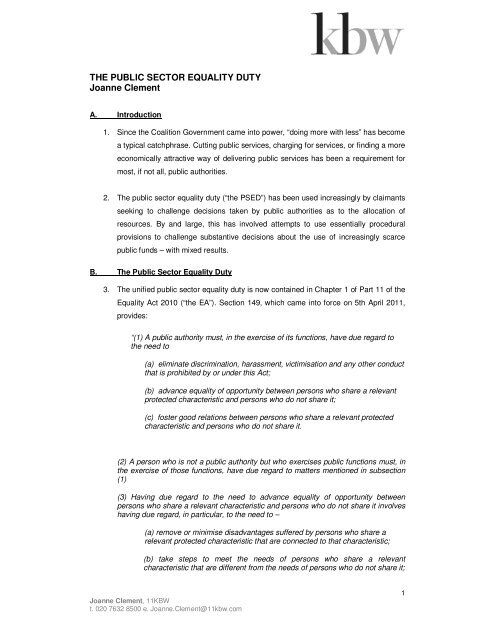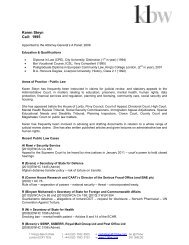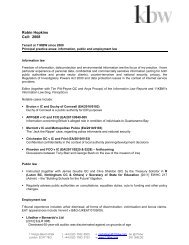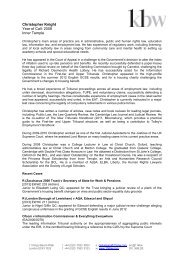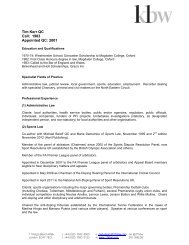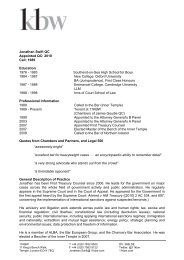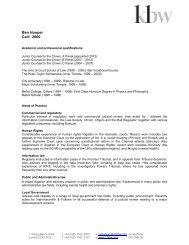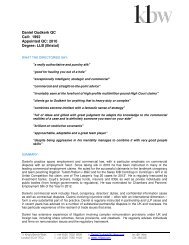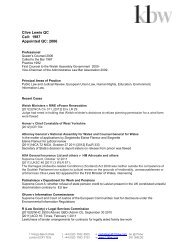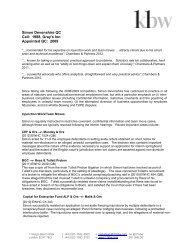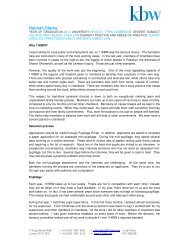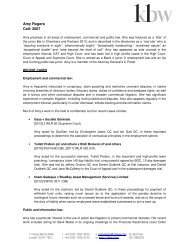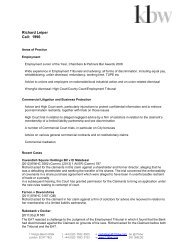THE PUBLIC SECTOR EQUALITY DUTY Joanne Clement - 11kbw
THE PUBLIC SECTOR EQUALITY DUTY Joanne Clement - 11kbw
THE PUBLIC SECTOR EQUALITY DUTY Joanne Clement - 11kbw
You also want an ePaper? Increase the reach of your titles
YUMPU automatically turns print PDFs into web optimized ePapers that Google loves.
<strong>THE</strong> <strong>PUBLIC</strong> <strong>SECTOR</strong> <strong>EQUALITY</strong> <strong>DUTY</strong><br />
<strong>Joanne</strong> <strong>Clement</strong><br />
A. Introduction<br />
1. Since the Coalition Government came into power, “doing more with less” has become<br />
a typical catchphrase. Cutting public services, charging for services, or finding a more<br />
economically attractive way of delivering public services has been a requirement for<br />
most, if not all, public authorities.<br />
2. The public sector equality duty (“the PSED”) has been used increasingly by claimants<br />
seeking to challenge decisions taken by public authorities as to the allocation of<br />
resources. By and large, this has involved attempts to use essentially procedural<br />
provisions to challenge substantive decisions about the use of increasingly scarce<br />
public funds – with mixed results.<br />
B. The Public Sector Equality Duty<br />
3. The unified public sector equality duty is now contained in Chapter 1 of Part 11 of the<br />
Equality Act 2010 (“the EA”). Section 149, which came into force on 5th April 2011,<br />
provides:<br />
“(1) A public authority must, in the exercise of its functions, have due regard to<br />
the need to<br />
(a) eliminate discrimination, harassment, victimisation and any other conduct<br />
that is prohibited by or under this Act;<br />
(b) advance equality of opportunity between persons who share a relevant<br />
protected characteristic and persons who do not share it;<br />
(c) foster good relations between persons who share a relevant protected<br />
characteristic and persons who do not share it.<br />
(2) A person who is not a public authority but who exercises public functions must, in<br />
the exercise of those functions, have due regard to matters mentioned in subsection<br />
(1)<br />
(3) Having due regard to the need to advance equality of opportunity between<br />
persons who share a relevant characteristic and persons who do not share it involves<br />
having due regard, in particular, to the need to –<br />
(a) remove or minimise disadvantages suffered by persons who share a<br />
relevant protected characteristic that are connected to that characteristic;<br />
(b) take steps to meet the needs of persons who share a relevant<br />
characteristic that are different from the needs of persons who do not share it;<br />
<strong>Joanne</strong> <strong>Clement</strong>, 11KBW<br />
t. 020 7632 8500 e. <strong>Joanne</strong>.<strong>Clement</strong>@<strong>11kbw</strong>.com<br />
1
(c) encourage persons who share a relevant protected characteristic to<br />
participate in public life or in any other activity in which participation by such<br />
persons is proportionately low.<br />
(4) The steps involved in meeting the needs of disabled persons that are different<br />
from the needs of persons who are not disabled include, in particular, steps to take<br />
account of disabled persons‟ disabilities.<br />
(5) Having due regard to the need to foster good relations between persons who<br />
share a relevant protected characteristic and persons who do not share it involves<br />
having due regard, in particular, to the need to –<br />
(a) tackle prejudice, and<br />
(b) promote understanding.<br />
(6) Compliance with the duties in this section may involve treating some persons<br />
more favourably than others; but that is not to be taken as permitting conduct that<br />
would otherwise be prohibited by or under this Act.<br />
(7) The relevant protected characteristics are – age; disability; gender reassignment;<br />
pregnancy and maternity; race; religion or belief; sex; sexual orientation.<br />
(8) A reference to conduct that is prohibited by or under this Act includes a reference<br />
to – (a) a breach of an equality clause or rule; (b) a breach of a non-discrimination<br />
rule. <br />
(9) Schedule 18 (exceptions) has effect.”<br />
4. The public sector equality duty thus has three primary limbs, namely the need to: (a)<br />
eliminate discrimination (in all its forms, including direct and indirect discrimination); (b)<br />
advance equality of opportunity; and (c) foster good relations between those sharing or<br />
not sharing protected characteristics.<br />
5. The equality of opportunity limb encompasses: (a) removed of disadvantage from<br />
particular groups; (b) meeting the needs of particular groups; and (c) encouraging underrepresented<br />
groups to participate in public life or other activities.<br />
6. The fostering good relations limb encompasses: (a) tackling prejudice; and (b) promoting<br />
understanding.<br />
7. Section 149 of the EA replaces and augments the previous public sector equality duties<br />
contained in section 76A of the Sex Discrimination Act 1975 (“the SDA”), section 71 of<br />
the Race Relations Act 1976 (“the RRA”) and section 49A of the Disability Discrimination<br />
Act 1995 (“the DDA”).<br />
8. There are important statements of principle set out by the Court of Appeal and the<br />
Divisional Court in R (Baker) v Secretary of State for Communities and Local<br />
<strong>Joanne</strong> <strong>Clement</strong>, 11KBW<br />
t. 020 7632 8500 e. <strong>Joanne</strong>.<strong>Clement</strong>@<strong>11kbw</strong>.com<br />
2
Government [2009] PTSR 809; and R (Brown) v Secretary of State for Work and<br />
Pensions [2009] PTSR 1506. In Baker, Dyson LJ emphasized that the equality duty is<br />
about process and not outcome. At paragraph 31, he stated:-<br />
“In my judgment, it is important to emphasise that the section 71(1) [the<br />
predecessor PSED under section 71(1) of the Race Relations Act 1976] duty is not<br />
a duty to achieve a result, namely to eliminate racial discrimination or to promote<br />
equality of opportunity and good relations between persons of different groups. It is<br />
a duty to have due regard to the need to achieve these goals. The distinction is<br />
vital….What is due regard? In my view, it is the regard that is appropriate in all the<br />
circumstances. These include on the one hand the importance of the areas of life of<br />
the members of the disadvantaged racial group that are affected by the inequality of<br />
opportunity and the extent of the inequality, and on the other hand, such<br />
countervailing factors as are relevant to the function which the decision maker is<br />
performing.”<br />
9. In Brown, Aitkens LJ, giving a judgment with which Scott Baker LJ agreed, set out a<br />
number of guiding principles at paragraphs 90-96, which are now referred to as the “six<br />
Brown principles:-<br />
(1) First, those in the public authority who have to take decisions must be made<br />
aware of their duty to have “due regard” to the identified goals. An incomplete<br />
or erroneous appreciation of the duties will mean that “due regard” has not<br />
been given to them;<br />
(2) Secondly, the “due regard” duty must be fulfilled before and at the time that a<br />
particular policy that might affect protected groups is being considered by the<br />
public authority in question. It involves a conscious approach and state of<br />
mind;<br />
(3) Thirdly, the duty must be exercised “in substance, with rigour and with an<br />
open mind”. However the fact that the authority has not mentioned specifically<br />
the duty in carrying out the particular function is not determinative of whether<br />
the duty under the statute has been performed. But it is good practice to<br />
make reference to the provision and any code or other non-statutory<br />
guidance ;<br />
(4) Fourthly, the duty is a non-delegable duty. It will always remain on the public<br />
authority charged with it. In practice, another body may actually carry out the<br />
practical steps, but the duty to have “due regard” will only be fulfilled by the<br />
relevant public authority if (a) it appoints a third party that is capable of<br />
fulfilling the due regard duty; and (2) the public authority maintains a proper<br />
supervision over the third party to ensure it carries out its due regard duty;<br />
<strong>Joanne</strong> <strong>Clement</strong>, 11KBW<br />
t. 020 7632 8500 e. <strong>Joanne</strong>.<strong>Clement</strong>@<strong>11kbw</strong>.com<br />
3
(5) Fifthly, the duty is a continuing one;<br />
(6) Sixthly, it is good practice to keep an adequate record showing that they had<br />
actually considered their equality duties and pondered relevant questions. If<br />
records are not kept it may make it more difficult, evidentially, for a public<br />
authority to persuade a court that it has fulfilled the duty.<br />
10. The principles set out in Brown have been approved by the Court of Appeal in R<br />
(Domb) v London Borough of Hammersmith and Fulham [2009] EWCA Civ 941. A<br />
number of other relevant propositions can be derived from other cases. The current<br />
position of the law was helpfully summarised by Kenneth Parker J in R (JG and MB) v<br />
Lancashire County Council [2011] EWHC 2295 (Admin); [2011] BLGR 909 at [43]-<br />
[44] as follows:<br />
“43. A number of principles emerge as follows:<br />
i) The statutory duty under Section 49A DDA is not one to<br />
achieve a particular substantive result (whether to promote<br />
equality or otherwise) but to have “due regard” to the need to<br />
achieve these goals. Due regard is regard that “is appropriate<br />
in all the circumstances” (Baker at para 31 by Dyson LJ (as he<br />
then was)).<br />
ii) The public authority must also pay regard to any<br />
countervailing factors which, in the context of the function<br />
being exercised, it is proper and reasonable for the public<br />
authority to consider. The weight to be given to the<br />
countervailing factors is a matter for the public authority, not<br />
the court, unless the assessment by the public authority is<br />
unreasonable or irrational (Baker at para 34, Brown at para<br />
82).<br />
iii) A failure to make explicit reference to the statute does not<br />
show that the duty has not been performed (Brown at para<br />
93). It is immaterial whether or not the decision-maker was<br />
even aware of the duty provided that in substance he had due<br />
regard to the matters specified in it (Baker at paras 36, 37, 40<br />
and 46).<br />
iv) There is no obligation in the DDA to carry out a formal EIA<br />
(Brown at para 89) although such an EIA is a helpful way of<br />
demonstrating that the statutory duty has been complied with.<br />
44. [Counsel for the claimants] laid emphasis on a number of<br />
other propositions that can be derived from the case law as<br />
follows:<br />
i) Due regard must be given “before and at the time that a<br />
particular policy that will or might affect disabled people is<br />
being considered by the public authority in question” (Brown<br />
at para 91).<br />
ii) Due regard to the duty must be “an essential preliminary” to<br />
any important policy decision not a “rearguard action following<br />
<strong>Joanne</strong> <strong>Clement</strong>, 11KBW<br />
t. 020 7632 8500 e. <strong>Joanne</strong>.<strong>Clement</strong>@<strong>11kbw</strong>.com<br />
4
a concluded decision” (R (BAPIO Action Limited) v SSHD<br />
[2007] EWCA Civ 1139 at para 3 by Sedley LJ).<br />
iii) Put another way, consideration of the duty must be “an<br />
integral part of the formulation of a proposed policy, not<br />
justification for its adoption” (R (Kaur) and others v Ealing LBC<br />
[2008] EWHC 2062 (Admin) at para 24 by Moses J (as he<br />
then was)).<br />
iv) “Due regard” means specific regard by way of conscious<br />
approach to the specified needs (R (Meany) v Harlow District<br />
Council [2009] EWHC 559 (Admin) at para 74; R (Boyejo) v<br />
Barnet LBC [2009] EWHC 3261 (Admin) at para 58).<br />
v) If a risk of adverse impact is identified consideration should be<br />
given to measures to avoid that impact before fixing on a<br />
particular solution (Kaur at para 44).”<br />
11. In this paper, I examine:-<br />
(1) The time at which the PSED must be discharged – i.e. what does the<br />
“formative stage” mean?<br />
(2) How the courts have applied the PSED in a number of different contexts,<br />
including<br />
(i) budget setting;<br />
(ii) cuts in universal services, or charges for universal services;<br />
(iii) cuts in services targeted at particular protected groups;<br />
(iv) decisions taken in respect of individuals in the discharge of<br />
specific statutory duties.<br />
C. Duty discharged at a “Formative Stage”<br />
12. The duty under section 149(1) is a duty imposed on a public authority “…in the<br />
exercise of its functions”. In R (Kaur) v London Borough of Ealing [2008] EWHC<br />
2062, Moses LJ paraphrased this requirement as a duty that applied when the local<br />
authority “was formulating” its proposals. This has subsequently been described as<br />
requiring the due regard to be had “at the formative stage”.<br />
13. In R (Bailey) v London Borough of Brent [2011] EWCA Civ 1586, the Claimant argued<br />
that the local authority had failed to discharge the duty at a formative stage. It was<br />
said that there had been a failure to consider the PSED “throughout” the procedure<br />
leading up to the decision because a proposal that six specified libraries should be<br />
closed had been tabled before an EIA had been conducted.<br />
<strong>Joanne</strong> <strong>Clement</strong>, 11KBW<br />
t. 020 7632 8500 e. <strong>Joanne</strong>.<strong>Clement</strong>@<strong>11kbw</strong>.com<br />
5
14. At first instance (in R (Bailey) v London Borough of Brent [2011] EWHC 2572<br />
(Admin)) the Judge gave this submission short shrift. He referred to the statutory<br />
language used in section 149(1), and concluded that the PSED had to be discharged<br />
at the time at which the Council exercised its functions. The point at which the<br />
Council exercised its library functions was the point at which they took the decision to<br />
close six libraries. At paragraph 122, he stated:-<br />
“The formative stage at which the duty must be performed, in the sense<br />
meant by the guidance and decisions, is not one or all of the earlier stages<br />
when the officers or Council are contemplating and working up various<br />
options. It must be performed before the decision is made and be part of the<br />
decision-making process, rather than as a justification for the decision after it<br />
has been taken. The issue has to be addressed in the exercise of the<br />
functions, using the statutory language rather than judicial exegesis. The<br />
point at which the Council here exercised its functions under s.7 was when it<br />
decided, at the April 2011 meeting, that the LTP should proceed, including<br />
the six closures ....” <br />
15. Ouseley J held that the issue was very much bound up with the contention that the<br />
Council approached the issue of equality and closures in April 2011 with a closed<br />
mind. He concluded that there was no evidence to support that contention. The EIA<br />
was a conscientious and thorough effort to grapple with the duty in section 149, in<br />
substance and with rigour. It set out to answer the relevant questions which library<br />
closures give rise to in relation to the equality duty. He concluded that the EIA was<br />
genuinely “a core part of the decision-making process”. It could not fairly be said that<br />
the decision to close six libraries had already been taken.<br />
16. The Equality and Human Rights Commission intervened before the Court of Appeal<br />
to make written submissions on this issue. The EHRC argued that the PSED applied<br />
at each stage of a decision-making process, and could not be “put to one side”<br />
pending an ultimate decision as to the adoption of a policy. It was argued that if a<br />
policy had been closely formulated without the duty being addressed, there was a<br />
real risk that any consideration would be too late to secure effective compliance.<br />
17. The Court of Appeal unanimously agreed that the Council had exercised its functions<br />
with due regard to the requirements under section 149. However, they retreated<br />
somewhat from the Judge’s conclusion that, so long as an EIA was produced before<br />
the ultimate decision was taken, that was sufficient to discharge the duty.<br />
(1) Pill LJ stated that it was not necessary for an EIA to be conducted before<br />
the formulation of the proposals on which the public were to be consulted<br />
(paragraph 84). He accepted that the Council had had section 149<br />
properly in mind from an early stage, and for that reason had decided to<br />
<strong>Joanne</strong> <strong>Clement</strong>, 11KBW<br />
t. 020 7632 8500 e. <strong>Joanne</strong>.<strong>Clement</strong>@<strong>11kbw</strong>.com<br />
6
carry out a full EIA for consideration, together with the results of the<br />
consultation. He dismissed the argument that the Council had put the<br />
relevant requirements to one side until the ultimate decision was taken.<br />
The Council had had regard to the PSED as “an integral part of the<br />
decision-making process” (see paragraph 84).<br />
(2) Davis LJ recognized that there cannot necessarily be easy identification<br />
of particular formative “stages” in every decision making process.<br />
However, it was unreal to require a “comprehensive scrutiny” (whatever<br />
that may mean) at every moment throughout the process. Precisely what<br />
consideration is due can and will vary from time to time during the<br />
process. An ultimate assessment will need to be made as to whether,<br />
overall, “due regard” had been given.<br />
(3) Davis LJ stated that to the extent that the Judge may at one stage in his<br />
judgment have indicated that a full EIA will always suffice provided only<br />
that it is produced prior to the decision finally being made that “may” be<br />
going too far. It is necessary that consideration of the duty “properly<br />
informs” the decision-making process before the ultimate decision is<br />
made. He left open the possibility that there may be cases, as the EHRC<br />
Guidance warns, where the very late and unheralded production of an<br />
EIA immediately prior to a final scheduled meeting may, depending on<br />
the circumstances, not suffice to discharge the duty (see paragraph 104).<br />
(4) In the present case, Davis LJ concluded that officers of the Council were<br />
plainly aware from the outset of, and they consulted as to, potential<br />
equality issues. Diversity implications and the need for an EIA had been<br />
noted at the outset, before the consultation on the proposals had begun.<br />
The requirements of the PSED were throughout in mind. The EIA was a<br />
thorough document, which was then properly considered by the Council<br />
before the actual decision was made. It could not be said that the PSED<br />
had been “put on one side pending the ultimate decision”.<br />
(5) Richards LJ agreed with both judgments.<br />
18. Where does that leave public authorities? If it is obvious that a proposal is likely to<br />
have equality implications, that should be recorded at an early stage. If it is obvious<br />
that a full EIA is going to be carried out, that should also be recorded at an early<br />
stage. If a consultation exercise is going to be embarked upon, that consultation<br />
should ask any questions necessary to ensure that the public authority has as much<br />
<strong>Joanne</strong> <strong>Clement</strong>, 11KBW<br />
t. 020 7632 8500 e. <strong>Joanne</strong>.<strong>Clement</strong>@<strong>11kbw</strong>.com<br />
7
information as possible about any potential equalities issues (and if that information is<br />
not already available to the public authority, it may need to consult just to obtain that<br />
information). If a full and detailed EIA is then produced and considered before the<br />
decision under challenge is taken, that will be sufficient to discharge the duty.<br />
D. Challenges to Budgets<br />
19. Attempts have been made to challenge decisions to adopt the overall budget for<br />
central and local government on the basis that there was a failure to comply with the<br />
PSED. The Courts have been reluctant to entertain such challenges.<br />
(i) Challenge to central Government budget<br />
20. In R (Fawcett Society) v Chancellor of the Exchequer & others [2010] EWHC 3522<br />
(Admin) Ouseley J refused to grant the Fawcett Society permission to judicially<br />
review the Coalition Government’s 2010 Emergency Budget on the grounds that the<br />
Chancellor had failed to comply with s.76A of the Sex Discrimination Act 1975. The<br />
criticism was that the Chancellor had failed to carry out a gender EIA of the Budget<br />
when it was proposed.<br />
21. The first part of the challenge focussed on the whole Budget and the public spending<br />
envelope which set departmental spending limits. No EIA had been produced that<br />
evaluated the potential impact on gender in respect of the budget. The Court<br />
accepted that the provisions of section 76A of the Sex Discrimination Act were in<br />
principle broad enough to apply to government action such as the preparation and<br />
presentation of the Budget, including public expenditure limits. Such actions would<br />
now clearly fall within section 149 of the 2010 Act.<br />
22. The Government argued that it was appropriate and legitimate to decide that the<br />
impact of the provisions of the Budget on gender equality objectives should be dealt<br />
with by reference to the impact of the various specific individual items within the<br />
Budget rather than on an overall basis. The claimant argued that this approach was<br />
unlawful, because it would cause the cumulative effect of the Budget on equality of<br />
opportunity to be ignored. Ouseley J accepted the Government’s submission that the<br />
varied measures, differing in nature, introduced or flagged in the Budget made impact<br />
assessment of the Budget as a whole inappropriate:<br />
“...if the analysis of gender equality impacts can adequately be<br />
undertaken by consideration of the line items in the Budget, the<br />
duty is fulfilled or rather not breached by its being dealt with in<br />
that way at that stage. For my part, I cannot see any reason why<br />
<strong>Joanne</strong> <strong>Clement</strong>, 11KBW<br />
t. 020 7632 8500 e. <strong>Joanne</strong>.<strong>Clement</strong>@<strong>11kbw</strong>.com<br />
8
the government is acting unlawfully if that is the way in which it<br />
proposes to deal with gender equality issues on the Budget.” [8].<br />
23. So far as setting the departmental spending envelope was concerned, no door had<br />
been irretrievably closed, and a departmental budget would inevitably have<br />
considerable scope for the reallocation of monies within it. It was lawful to consider<br />
the impact of particular measures in advance of specific implementation.<br />
24. Criticism was also made of the lack of EIA in respect of specific budget items (such<br />
as the increase in VAT). As to some of these, the Government conceded that more<br />
should have been done but the Judge accepted that, those matters now having been<br />
enacted in legislation, the challenge in respect of them was academic (see [11] and<br />
[12]). As to others, the Government had formed the view that an EIA would be carried<br />
out at a later point when the policy was more fully developed. Ouseley J said that that<br />
judgement having been rational, there was no basis for holding the absence of EIA<br />
unlawful at the earlier stage ([15]). So this is a helpful case for central government in<br />
its relatively generous approach as to the latitude it has to determine when an<br />
assessment of equality impact is required. 1<br />
25. The Court also emphasized the need for any challenge to budget setting to be<br />
brought expeditiously. It was obviously imperative that the public and corporate world<br />
(individual and foreign) had certainty about the budgetary affairs of the United<br />
Kingdom. The original proceedings to quash the Budget were started some five<br />
weeks after the Budget, and after some of the measures had been passed into<br />
legislation. What is “prompt” in this context is likely to be very short indeed.<br />
(ii) Challenges to budget setting by local authorities<br />
26. There have been a number of challenges to the budgets set by local authorities,<br />
which have been equally unsuccessful.<br />
1 On 25th November 2010, the Equality and Human Rights Commission (“the EHRC”)<br />
announced that it would assess formally, under s.31 of the Equality Act 2006 the extent to<br />
which HM Treasury complied with the duties when considering the impact of the decisions<br />
contained in the Spending Review on protected characteristics. This is described on the<br />
EHRC’s website as follows: “The assessment is an opportunity for the Commission to<br />
continue its ongoing constructive work with HM Treasury to evaluate what steps it has<br />
undertaken to comply with the legislation and identify any potential opportunities for<br />
improvement and any lessons to be learnt across Government to improve outcomes for<br />
protected groups by putting fairness and transparency at the heart of difficult decisions.” The<br />
terms of reference were settled on 12 th January 2011. The EHRC has obtained evidence from<br />
HM Treasury and representations from nine outside bodies. Oral evidence was received<br />
during May and June 2011. The EHRC intended to report its findings in the Autumn, so that it<br />
could be taken into account in the preparations for the 2012 budget. To date, the EHRC has<br />
not published its report.<br />
<strong>Joanne</strong> <strong>Clement</strong>, 11KBW<br />
t. 020 7632 8500 e. <strong>Joanne</strong>.<strong>Clement</strong>@<strong>11kbw</strong>.com<br />
9
27. In R (JG and MB) v Lancashire County Council [2011] EWHC 2295 (Admin), the<br />
claimants challenged the decision of full council to approve revenue budget proposals<br />
for three years, including a budget limit for adult social care services. The budget<br />
included two policy proposals – first, a policy to raise the eligibility threshold for<br />
access to adult social care services, and second, a policy to change how it charged<br />
for such services. The budget decision was taken at a meeting in February 2011. The<br />
approval by full council was to be subject to further consideration by the Cabinet<br />
Member. In March 2011 the Cabinet Member for Adult and Community Services<br />
approved policies in the budget including to raise eligibility thresholds for access to<br />
adult social care from “moderate” to “substantial” or “critical” (as assessed under<br />
FACS).<br />
28. The claimants argued that there had been a breach of the PSED because at the time<br />
the initial budget decision was taken, there had been no detailed assessment of the<br />
likely impact of the budget decision on the affected users of the relevant services.<br />
Kenneth Parker J rejected the challenge (relying on the protected characteristic of<br />
disability) in relation to the full council’s budget decision for essentially the following<br />
reasons (see [48]-[51]):<br />
(1) It was clear to those involved in approving the budget that disabled people would<br />
be adversely affected by budget reductions to adult social services. The potential<br />
impact was specifically identified for further investigation, and as part of that<br />
investigation there was put in train a series of consultations.<br />
(2) The approval of the Council’s overall budget did not constitute a final decision<br />
about what the Council’s policies would be or even about what sum of money<br />
would, in fact, be saved under each of the service proposals. It was obvious to<br />
the Council’s Members that the proposal to change the social care threshold<br />
would be implemented only after due regard had been paid to the need to<br />
promote equality of opportunity and to take steps to take account of disabled<br />
person’s disabilities.<br />
(3) The reality was that the decision-maker had taken a preliminary decision in<br />
relation to its budget, fully aware that the implementation of proposed policies<br />
would be likely to have an impact on the affected users, but had not committed<br />
itself to the implementation of specific policies within the budget framework until it<br />
had carried out a full and detailed assessment of the likely impact. There was<br />
nothing wrong, in principle, with such an approach and nothing inconsistent with<br />
the duties under the DDA.<br />
<strong>Joanne</strong> <strong>Clement</strong>, 11KBW<br />
t. 020 7632 8500 e. <strong>Joanne</strong>.<strong>Clement</strong>@<strong>11kbw</strong>.com<br />
10
(4) By parity of reasoning with Fawcett Society it was sensible, and lawful, for the<br />
Council first to formulate its budget proposals and then, at the time of developing<br />
the policies that were now under challenge, to consider the specific impact of<br />
policies that might be implemented under the budget framework.<br />
29. A further challenge to a local authority’s budget was heard earlier this year in the<br />
case of R (D and S) v Manchester City Council [2012] EWHC 17 (Admin). The<br />
claimants challenged the local authority’s budget decision, which had reduced the<br />
budget for adult social care by £17 million over the next two years, as a result of the<br />
financial constraints placed upon the authority. It was argued that the decision had<br />
been taken without due regard to the disability equality duty contained in section 49A<br />
of the DDA.<br />
30. Ryder J dismissed the claim. The local authority had had the statutory duties in mind.<br />
The budget was constructed following a pre-budget consultation that led to a<br />
framework and principles whose overt aim was to safeguard those in greatest need<br />
and to provide sufficient resources to effectively safeguard and protect the most<br />
vulnerable. Monies were identified for that purpose. It was recognised that further<br />
consultation and equality impact assessments were required and that decisions by<br />
the executive would be needed. This might require the use of resources additional to<br />
those budgeted for, from reserves if necessary. The local authority recognised the<br />
need for an analysis of the impact of the budget cuts which it acknowledged would<br />
have to be taken into account.<br />
31. The Court held that this was a proper and lawful budget strategy, which took into<br />
account a pre-budget consultation. To the extent that the budget decision relied upon<br />
contingency planning and the identification of reserves to meet statutory obligations,<br />
it was a strategy based on good budgeting practice and local authority governance.<br />
At paragraph 59, the Court stated:-<br />
“Good governance demands that a budget is not only an estimate of planned<br />
spending, it is also a projection based upon foreseeable risks which includes<br />
a contingency for uncertainties. Where risk assessments are incomplete or<br />
inchoate and/or financial circumstances are such that predictions are<br />
necessarily less certain, the contingency becomes all the more important.<br />
Here it was crucial. Were this not to be the case, budgets of many public<br />
bodies would be impugned by the erroneous elision of uncertainty with<br />
unfairness and/or illegality. That is not in any way to suggest that the public<br />
sector equality duty or its predecessor do not apply to budgetary decisions:<br />
they categorically do, but where flexibility is built into the budget so that<br />
subsequent corporate decisions and decisions relating to individuals can still<br />
lawfully be made by reference to the potential impact of the proposals on the<br />
persons affected then it is possible for the duty to be complied with i.e. there<br />
<strong>Joanne</strong> <strong>Clement</strong>, 11KBW<br />
t. 020 7632 8500 e. <strong>Joanne</strong>.<strong>Clement</strong>@<strong>11kbw</strong>.com<br />
11
is nothing wrong in principle with such an approach and nothing inconsistent<br />
with the duties under the DDA 1995 or the EA 2010.<br />
32. No EIA had been conducted at the budget stage, but there was no statutory duty to<br />
carry out a formal EIA. The Court concluded that the Council had clearly had due<br />
regard to the needs of disabled people when setting the budget. The Council had<br />
recognized the need for an analysis of the impact, which it acknowledged would have<br />
be taken into account at a later date. It put in place a strategic response – i.e. a<br />
contingency fund and guarantees as to how an individual’s needs would still be met –<br />
and procedural and substantive protections for those affected. That amounted to<br />
consideration of the impact which was consistent with the need to have due regard<br />
and was a consideration of substance, not mere form: it involved a commitment, if<br />
necessary, of real money.<br />
33. Even if the claim had had merit, the Court would still have refused relief. If any relief<br />
were to be granted in respect of the Council’s budget calculation, as a matter of law,<br />
it must be quashed. This would invalidate the council tax which had been set, and<br />
would incur additional costs in the re-calculation and re-setting of the tax and reissuing<br />
tax demands. There was clear evidence that there was no realistic prospect<br />
that the Council would set a higher council tax, with the obvious implication that any<br />
relief which quashed the same would only have the effect of reducing the resources<br />
available. Ryder J concluded that invalidating the council tax for the year would be<br />
disproportionate, contrary to the public interest and would serve no intelligible<br />
purpose: see paragraph 85.<br />
E. Universal Services<br />
34. The next area to consider is how the courts have approached the PSED in relation to<br />
cuts or charges to services that are available to all. Challenges have typically alleged<br />
that the public authority has not exercised the PSED in substance and with rigour (the<br />
third Brown principle).<br />
35. In considering the impact of cuts or charges to such services, a public authority will<br />
need to consider:-<br />
(1) whether the proposal affects a particular protected group in a specific<br />
way over and above any impact on other groups in the community; and<br />
(2) whether the proposal has a disproportionate impact on a particular<br />
protected group, i.e. whether there is an obvious risk of indirect<br />
discrimination through “tainting by numbers”.<br />
<strong>Joanne</strong> <strong>Clement</strong>, 11KBW<br />
t. 020 7632 8500 e. <strong>Joanne</strong>.<strong>Clement</strong>@<strong>11kbw</strong>.com<br />
12
36. It is absolutely critical in this area that the public authority fully and fairly identifies the<br />
likely impact on protected groups. As the duty is simply a duty to have due regard to<br />
the various equality needs, if an adverse impact is identified, the public authority may<br />
still proceed with the proposal. But what a public authority must ensure is that it is<br />
fully aware of the likely impact on the equality needs set out in the PSED before it<br />
takes the decision. If an EIA does not identify obvious negative impacts, the courts<br />
are likely to find that the authority has not complied with the PSED.<br />
37. One such universal service is a library service offered by library authorities to all<br />
those who live, work and study in their area. When considering library closures, there<br />
are certain obvious ways in which protected groups may be particularly affected. For<br />
example, the disabled and the elderly may find it more difficult to get to the next<br />
nearest library. Very young children, who use libraries for reading groups/toddler<br />
groups may be affected. School pupils who use the library for study spaces may be<br />
affected. The public authority must consider the nature and extent of these likely<br />
effects, and any ways in which they can be mitigated. The main mitigation in this<br />
context concerned (i) accessibility of alternative libraries; (ii) the improved services on<br />
offer at the alternative libraries; and (iii) use of a home visits/outreach service to<br />
provide facilities to those who could not access an alternative library building.<br />
38. In Bailey, the claimants put forward two main arguments to contend that the Council<br />
had not complied with the “substance” of the PSED. First, it was said that it was<br />
unlawful for the Council not to carry out an assessment of the relative equality<br />
impacts of other courses of action which the Council had not put forward for<br />
consultation as its preferred option, such as keeping libraries open for fewer hours, or<br />
closing other libraries, or community involvement. Secondly, it was argued that the<br />
EIA did consider what the claimants termed the “obvious risk” of indirect<br />
discrimination.<br />
39. At first instance, Ouseley J dismissed both arguments. He held that the duty in<br />
section 149 can be performed by focusing on the effect of the decision or policy<br />
which is proposed, and there was no obligation to analyse in equalities terms the<br />
whole range of possible options (paragraphs 129-130). He also held that there was<br />
no evidence of a risk of indirect discrimination, to demonstrate that the Council had<br />
failed to discharge the PSED by failing to have regard to it.<br />
40. Before the Court of Appeal, the main ground of appeal was that the Council had<br />
breached section 149(1) of the 2010 Act by failing to have due regard to the risk of<br />
<strong>Joanne</strong> <strong>Clement</strong>, 11KBW<br />
t. 020 7632 8500 e. <strong>Joanne</strong>.<strong>Clement</strong>@<strong>11kbw</strong>.com<br />
13
indirect discrimination against Asian residents of the borough. The Court of Appeal<br />
unanimously dismissed the appeal.<br />
41. The definition of indirect discrimination is found in section 19 of the Equality Act 2010<br />
(copy attached). In short, indirect discrimination arises if a public authority applies a<br />
neutral provision, criterion or practice to everyone, but which (i) places a group of<br />
people sharing a protected characteristic at a particular disadvantage when<br />
compared with persons who are not part of that protected group; and (ii) which<br />
cannot be objectively justified.<br />
42. On the indirect discrimination point, the Court held that:-<br />
(1) First, a decision to close libraries was capable of being a “provision,<br />
criterion or practice” within the meaning of section 19 of the 2010 Act;<br />
(2) Secondly, there is no need for there to be an intrinsic link between the<br />
relevant protected characteristic (in this case, race) and the particular<br />
disadvantage suffered. It is possible to establish indirect discrimination by<br />
comparing the proportion of Asians adversely affected by the proposal<br />
with the proportion of non-Asians so affected. If the statistics reveal<br />
Asians are placed at a “particular disadvantage” when compared to non-<br />
Asians, a prima facie case of indirect discrimination will be made out.<br />
(3) Thirdly, it was not enough to establish a risk of indirect discrimination<br />
against Asians to demonstrate that they were the most numerically<br />
disadvantaged – that followed from the fact that they were the largest<br />
ethnic group amongst the users of Brent libraries. The appropriate “pool”<br />
for indirect discrimination purposes was library users, rather than a pool<br />
comprising the entire population of the borough (the vast majority of<br />
whom did not use library services). If that pool was used, the statistics<br />
did not support any claim that there was indirect discrimination. The<br />
Asian users of the libraries were not proportionately more disadvantaged<br />
than non-Asians. 76% of Asian users and 76% of non-Asian users use<br />
the libraries that remain and 24% of Asian users and 24% of non Asian<br />
users use the libraries that will close.<br />
43. The Court also noted that the possibility of discrimination, direct or indirect, against<br />
the Asian community or Asian library users never really featured in the evidence filed<br />
by the claimants or in objections made before the Council’s decision. The point about<br />
indirect discrimination had been used as a collateral means of achieving the desired<br />
<strong>Joanne</strong> <strong>Clement</strong>, 11KBW<br />
t. 020 7632 8500 e. <strong>Joanne</strong>.<strong>Clement</strong>@<strong>11kbw</strong>.com<br />
14
esult, i.e. quashing the decision. He described the appellants’ argument on section<br />
149 of the Equality Act 2010 as being “artificial and wrong” (paragraph 89, 97). The<br />
Court of Appeal upheld the finding of Ouseley J to the effect that the EIA was<br />
informed and through and addressed the relevant issues in substance and with<br />
rigour. The EIA had itself expressly drawn attention at the outset, in general terms, to<br />
a likelihood of a differential impact on a group on grounds of ethnicity. The statistics<br />
lent no support to the appellant’s case. There was no obvious risk of indirect<br />
discrimination otherwise arising requiring any greater consideration than was already<br />
evidenced in the April Report to members and the equality impact assessment.<br />
44. Davis LJ concluded by emphasising the importance of complying with section 149.<br />
However, in a case where the Council was fully apprised of its duty under section 149<br />
and had the benefit of a most careful Report and EIA, Davis LJ concluded that an “air<br />
of unreality” had descended over this line of attack. Councils cannot be expected to<br />
speculate on or to investigate or to explore such matters ad infinitum; nor can they be<br />
expected to apply, indeed they are to be discouraged from applying, the degree of<br />
forensic analysis for the purpose of an EIA and of consideration of their duties under<br />
section 149 which a QC might deploy in court. In situations where hard choices have<br />
to be made, the judge recognised that to accede to the approach urged by the<br />
appellants would be to make effective decision making on the part of local authorities<br />
and other public bodies unduly and unreasonably onerous (see paragraph 102). <br />
45. In the second libraries case – that of R (Green) v Gloucester County Council [2011]<br />
EWHC 2687 (Admin), the Claimant succeeded in establishing a breach of the PSED.<br />
The Court was critical of the first EIA that concluded that the library closure proposal<br />
would have a neutral impact on protected groups. The second EIA identified only one<br />
potential negative impact in respect of the removal of mobile libraries. There was no<br />
consideration of the potential impact of the closure of static library buildings or the<br />
reduction in opening hours. For example, there was no analysis of whether disabled<br />
people had particular needs, or whether they might be less likely to access another<br />
library. The court concluded that both authorities should have undertaken a<br />
sufficiently thorough information gathering exercise and then properly analysed that<br />
information. They had failed to do so (paragraph 131).<br />
46. Also of note is the recent decision of the Divisional Court in the challenge to the<br />
decision to increase tuition fees – R (Hurley and Moore) v Secretary of State for<br />
Business, Innovation and Skills [2012] EWHC 201 (Admin). The Claimant challenged<br />
the regulations that implemented the increase in tuition fees on the basis that the<br />
Secretary of State had failed to have regard to, in particular, the duty contained in<br />
section 71(1) of the Race Relations Act 1976. Essentially, the Claimant argued that<br />
<strong>Joanne</strong> <strong>Clement</strong>, 11KBW<br />
t. 020 7632 8500 e. <strong>Joanne</strong>.<strong>Clement</strong>@<strong>11kbw</strong>.com<br />
15
that the increase in tuition fees would have a significant affect on the sociallydisadvantaged,<br />
making them less likely to go to university. As ethnic minorities were<br />
disproportionately represented in this group, the increase in tuition fees gave rise to a<br />
risk of indirect discrimination.<br />
47. The Secretary of State relied on impact assessments prepared before the<br />
Regulations were made which drew on the extensive material gathered as part of the<br />
year long Browne Review into the future funding of higher education. The<br />
assessments concluded that taking the whole of the reforms together, they ought not<br />
adversely to affect individuals form the lower socio-economic backgrounds<br />
disproportionately.<br />
48. The Divisional Court concluded that:-<br />
(1) The Secretaryof State had made a judgment as to the potential effect of<br />
the policies in the light of the available evidence. That judgment was<br />
made in good faith and was not irrational.<br />
(2) It was fanciful to suggest that there was no analysis of the relevant<br />
evidence. The central feature of the Browne Review had been to focus<br />
on ways in which the socially disadvantaged could be encouraged to<br />
participate in higher education;<br />
(3) It was hopeless to say that the duty had not been complied with because<br />
it was possible to point to one or other pieces of evidence which might be<br />
considered relevant which were not specifically identified in the EIA.<br />
(4) It was necessary to consider what impact the increase in fees would<br />
have. There is no basis to suggest that the imposition of fees at the<br />
proposed level would discriminate directly against any of the protected<br />
groups. The effect, if there be any, will be indirect. The obvious reason<br />
why minority protected groups might be adversely affected - and indeed,<br />
apart from the interest problem for some Islamic students, in all likelihood<br />
the only way - is because they are disproportionately economically<br />
disadvantaged. If they are not disadvantaged in that way, there is no<br />
reason to suppose that they will be disproportionately affected at all. The<br />
Secretary of State engaged fully with the implications for the<br />
economically disadvantaged. and therefore with the adverse impact on<br />
minority groups On any view, therefore, there had been “very substantial<br />
compliance” with the PSED.<br />
<strong>Joanne</strong> <strong>Clement</strong>, 11KBW<br />
t. 020 7632 8500 e. <strong>Joanne</strong>.<strong>Clement</strong>@<strong>11kbw</strong>.com<br />
16
(5) However, at paragraph 96, Elias LJ went on to state that if there was<br />
“any doubt” about whether a particular statutory objective is engaged, the<br />
issue needs to be explored before any conclusion can be safely reached<br />
that it is not. Insofar as the EIA purported to focus on the full package of<br />
reforms then under consideration and not merely the decision to increase<br />
fees, I cannot be sure that this has been done. I cannot discount the<br />
possibility that a more precise focus on the specific statutory duties might<br />
have led to the conclusion that some other requirements were potentially<br />
engaged and merited considerations…” <br />
(6) He “therefore conclude[d] that the Secretary of State did not carry out the<br />
rigorous attention to the PSEDs which he was obliged to do”, but was<br />
“satisfied that he did give proper consideration to those particular aspects<br />
of the duty which related to the principle of levying fees and the amounts<br />
of those fees”. Since the challenge was directed against the Regulations<br />
which increased fees, it is surprising that he concluded that the PSED<br />
had been breached at all. In any event, he held that it was not<br />
appropriate to quash the Regulations, and restricted relief to a<br />
declaration.<br />
E. Cuts to Services Targeted at Protected Groups<br />
49. A number of cases have considered cuts made to services targeted towards<br />
protected groups. The Courts have been more willing to interfere in this area and to<br />
quash the decisions made. Two recent examples involving Birmingham City Council<br />
illustrate this approach.<br />
50. R (Rahman) v Birmingham City Council [2011] EWHC 944 (Admin) concerned the<br />
termination by the council of funding to legal entitlement advice services supplied<br />
from centres run by voluntary agencies. The centres provided advice to minority<br />
ethnic communities and the physically and mentally disabled. A consultant’s report<br />
had recommended moving away from provision on a single ethnicity or single<br />
interest group basis. When the first decision was taken by the council’s Cabinet on 29<br />
November 2010, the EIA which had been produced was not available to the decisionmakers.<br />
When the claimants instituted proceedings the council realised this omission<br />
and held a further meeting on 14 March 2011 at which members were asked to<br />
reaffirm their decision in the light of the EIA. The members were specifically reminded<br />
to approach the decision with an open mind.<br />
51. The claimants were either disabled or members of minority ethnic communities (or<br />
both). It was common ground that the decision would have a disadvantageous effect<br />
<strong>Joanne</strong> <strong>Clement</strong>, 11KBW<br />
t. 020 7632 8500 e. <strong>Joanne</strong>.<strong>Clement</strong>@<strong>11kbw</strong>.com<br />
17
on members of protected groups. Unsurprisingly Blake J held that the first decision<br />
was unlawful as the equality duties had not been complied with as there was no<br />
evidence that each of the decision-makers were aware of the duty and how it was<br />
engaged [32]-[33].<br />
52. When the decision was re-taken with the benefit of the EIA, Blake J found that the<br />
duties had still not been properly discharged as the EIA was defective, having<br />
focused upon the advantages to be derived from a new policy rather than the degree<br />
of disadvantage to existing users of terminating funding arrangements until new<br />
arrangements could be put in place [35(1)]. He also found that the EIA had not been<br />
based on adequate consultation and consultation was particularly important where<br />
the council relied on a user survey which did not provide the relevant information<br />
[35(2)-(3)]. The expectation of consultation was also enhanced by communications<br />
suggesting that service users would be involved in commissioning [35(6)]. Blake J<br />
also held that the statutory equality duties require due regard to be had to the<br />
statutory need, not simply to the EIA, and decision-makers need to have due regard<br />
to all the evidence of prejudice and what might reasonably be done to mitigate it,<br />
even if that material is not in the EIA [35(7)]. It was “striking” that the case for<br />
continuing the existing service, at least in some areas where no alternatives existed,<br />
was never put in the reports before members or the decisions [36]. The Judge further<br />
pointed out that the fact that it is for a public authority to determine the weight to<br />
attach to countervailing factors can only be of assistance to a defendant where they<br />
have complied with the duty to have due regard to the statutory needs (see [37]).<br />
53. Blake J provided something of a warning to local authorities hoping to rely on the<br />
inherent difficulty of the decisions facing them [46]:<br />
“…Even where the context of decision making is financial resources in a<br />
tight budget, that does not excuse compliance with the PSEDs and indeed<br />
there is much to be said for the proposition that even in the straightened<br />
times the need for clear, well-informed decision making when assessing<br />
the impacts on less advantaged members of society is as great, if not<br />
greater. In general terms I consider the advice recently issued in nonstatutory<br />
guidance by the Equality and Human Rights Commission ("Using<br />
the equality duties to make fair financial decisions") to be of assistance to<br />
decision makers such as this defendant in the no doubt very difficult<br />
decisions that have to be taken in this field…”<br />
54. The second Birmingham case is R (W) v Birmingham City Council [2011] EWHC<br />
1147 (Admin), (2011) 120 BMLR 134. In a voluminous 100 page judgment Walker J<br />
granted judicial review of the council’s decision to alter its eligibility threshold for adult<br />
social care from “substantial” to “critical” (as assessed using the FACS guidance).<br />
55. In December 2010 the council had issued a consultation document on the future of<br />
adult social services. The consultation period was to run until 2 March 2011. Option 2<br />
<strong>Joanne</strong> <strong>Clement</strong>, 11KBW<br />
t. 020 7632 8500 e. <strong>Joanne</strong>.<strong>Clement</strong>@<strong>11kbw</strong>.com<br />
18
in the consultation document included the proposal to limit eligibility to those with<br />
critical care needs. There was criticism by a number of the consultees of a lack of<br />
clarity in how the council worded the proposal. On 1 March 2011 the full council met<br />
and decided to adopt the Business Plan 2011+. In an appendix to the Business Plan<br />
was set out much of Option 2 from the consultation document. On. A corporate EIA<br />
and an EIA for Adult and Community Services were available as background papers.<br />
On 14 March 2011 a meeting of the council’s Cabinet approved a report<br />
recommending the adoption of Option 2.<br />
56. The claimants were severely disabled persons. They challenged the decisions of the<br />
full council and the Cabinet alleging failure to comply with s.49A of the DDA. Once<br />
again the legal principles (which Walker J summarised at [151]) were not in dispute –<br />
the issue was their application to the facts.<br />
57. The council’s case was that that the claimants were trying to mount a micro level<br />
challenge to what were high level, macro decisions. It also submitted that it was<br />
unreal to suggest that the council was not aware of the equality impacts of the<br />
decisions being contemplated as the impacts were “inherently obvious”.<br />
58. On the central issue of the so-called ‘move to “critical only”’, Walker J rejected these<br />
arguments for, essentially the following reasons [176]-[183]:<br />
a. It was not the role of the court to get involved in minute scrutiny of a mass of<br />
detail and the proposed move to “critical only” involved a “macro decision”.<br />
b. Analysis of all that was done by the council in the period from November<br />
2010 onwards showed that the council did not, in any real sense, refine and<br />
focus what in November 2010 was necessarily a “high level and generalised”<br />
description of the likely impact of moving to “critical only”. It was difficult to<br />
see how, in the circumstances of the present case, “due regard” could be<br />
paid to the matters identified in DDA, s.49A without some attempt at<br />
assessment of the practical impact on those whose needs in a particular<br />
respect fell into the “substantial” band but not into the “critical” band.<br />
c. The decision to consult “on broad options” required consideration of a<br />
subsidiary question whether to go beyond generalities in assessing the likely<br />
impact of the proposed course upon individuals with “substantial” needs. At<br />
the very least in order to pay “due regard” the council, when deciding to<br />
consult “on broad options”, needed to consider whether its answer to the<br />
subsidiary question was consistent with its duty under s.49A.<br />
<strong>Joanne</strong> <strong>Clement</strong>, 11KBW<br />
t. 020 7632 8500 e. <strong>Joanne</strong>.<strong>Clement</strong>@<strong>11kbw</strong>.com<br />
19
d. Throughout the process the council was giving consideration to how to<br />
address the needs of the disabled. In that sense its decisions taken in<br />
relation to adult social care were decisions which were relevant to its<br />
performance of the s.49A duty. But that is not the same thing as doing what<br />
s.49A seeks to ensure: namely to consider the impact of a proposed decision<br />
and ask whether a decision with that potential impact would be consistent<br />
with the need to pay due regard to the principles of disability equality.<br />
e. Conspicuously absent from the material before Cabinet was any express<br />
statement that Cabinet must consider whether s.49A required it to take the<br />
course of ensuring further spending resources were allocated to Adult and<br />
Community Services, in particular because of the potential severity of the<br />
impact of the proposed move to “critical only.”<br />
f. There was a failure by the council on 1 March 2011 and Cabinet on 14 March<br />
2011 to focus on the questions required to be asked and so the decisions of<br />
1 and 14 March 2011 on the proposals for adult social care were unlawful.<br />
g. There was not in the material prepared for the meetings any assessment of<br />
the extent to which such mitigating factors as were mentioned would or would<br />
not reduce the potential severity of the proposed move to “critical only”. In the<br />
EIAs, if members had consulted them, neither the analysis nor the suggested<br />
action plans attempted to examine what the actual impact of the move to<br />
“critical only” would be or how it would be affected by mitigating measures.<br />
Had members appreciated the need to consider the right questions, they<br />
would not have had the wherewithal to answer it.<br />
59. In R (Greenwich Community Law Centre) v Greenwich LBC [2011] EWHC 3463<br />
(Admin), the Administrative Court (Cranston J) dismissed a challenge by a leading<br />
law centre to the decision by Greenwich Council to withdraw its funding of around<br />
£200,000 per year. The law centre provided services to vulnerable clients who fell<br />
within the protected groups. The Council's decision followed a tender process for<br />
funding for legal services, which resulted in awards to four of five previously funded<br />
organisations but not to Greenwich CLC.<br />
60. The High Court held that where a tender process for the award of third sector funding<br />
had been designed with the statutory equality duties in mind, and was intended to<br />
result in the award of funding to the organisations submitting the tenders best suited<br />
to the Council's requirements, there was no obligation to conduct a further equalities<br />
<strong>Joanne</strong> <strong>Clement</strong>, 11KBW<br />
t. 020 7632 8500 e. <strong>Joanne</strong>.<strong>Clement</strong>@<strong>11kbw</strong>.com<br />
20
assessment before making funding awards. The Council had conducted an equality<br />
impact assessment in March 2011 in advance of its decision not to award funding for<br />
legal advice services and instead to conduct a fresh commissioning round. It paid due<br />
regard in substance to its equalities duties under the Equality Act 2010 by remaining<br />
faithful to the focus on priority groups in the tendering exercise. There was no need<br />
for a further equality impact assessment with regard to the outcome since the logic of<br />
the tender process meant that performance of the duty was integral to the outcome.<br />
Selection of the winning tenders would inevitably pay due regard to the equalities<br />
objectives. No new or different equalities considerations arose.<br />
61. This decision is currently on appeal to the Court of Appeal on these issues, together<br />
with a new point, which is that the Council’s decision to award funding to other<br />
agencies instead of the appellant had been flawed because there had been no<br />
express consideration of the needs of 5 of the 8 protected characteristics: gender<br />
reassignment; pregnancy; religion or belief; sex; and sexual orientation.<br />
F. Individual Decisions<br />
62. The courts are wary of the artificially “tacked on” claim in respect of the PSED,<br />
particularly where a claim is brought on behalf of an individual for alleged breaches of<br />
substantive rights. Thus in R (MS) v Oldham MBC [2010] EWHC 802 (Admin),<br />
Langstaff J said, in the context of a local authority‟s assessment of a child‟s special<br />
needs (at [20]):<br />
“ ... I would deprecate any statement of principle which required a court in<br />
any case involving a disabled claimant seeking provision from a local<br />
authority to the effect that the local authority would have to minute and record<br />
in part of its paperwork the fact that it had regard to each or any of the six<br />
specific matters set out in section 49A. If it were to do so it would risk<br />
reducing to a mantra what ought to be a matter of central substance in the<br />
local authority’s behaviour. That does not mean that a court may not enquire<br />
into the matter, and where it looks at first blush as though the local authority<br />
may not have had regard to such matters the court would plainly be helped<br />
by such documentation as there is: but it does not require, in my view,<br />
another tick box to be ticked for the sake of it, nor for wording to be adopted<br />
purely in defence of potential but unfounded claims for review.”<br />
63. The claim under the DDA did not add anything of substance to the claim as otherwise<br />
advance under community care legislation.<br />
64. This approach has been endorsed by the Supreme Court in R (Mcdonald) v<br />
Kensington and Chelsea [2011] UKSC 33, where Lord Brown stated that the<br />
appellant’s argument based on the PSED was hopeless. Where a person is disabled<br />
and the public authority is discharging its functions under statutes which expressly<br />
direct their attention to the needs of disabled persons, it may be entirely superfluous<br />
<strong>Joanne</strong> <strong>Clement</strong>, 11KBW<br />
t. 020 7632 8500 e. <strong>Joanne</strong>.<strong>Clement</strong>@<strong>11kbw</strong>.com<br />
21
to make express reference to the PSED and absurd to infer from an omission to do<br />
so a failure on the authority's part to have regard to their general duty under the<br />
section. The question is one of substance, not of form.<br />
<strong>Joanne</strong> <strong>Clement</strong><br />
March 2012<br />
<strong>Joanne</strong> <strong>Clement</strong>, 11KBW<br />
t. 020 7632 8500 e. <strong>Joanne</strong>.<strong>Clement</strong>@<strong>11kbw</strong>.com<br />
22


